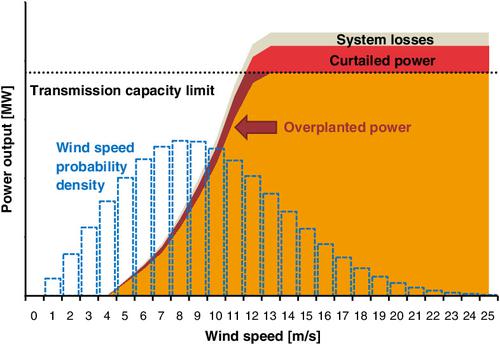当前位置:
X-MOL 学术
›
WIREs Energy Environ.
›
论文详情
Our official English website, www.x-mol.net, welcomes your feedback! (Note: you will need to create a separate account there.)
Overplanting in offshore wind power plants in different regulatory regimes
Wiley Interdisciplinary Reviews: Energy and Environment ( IF 6.1 ) Pub Date : 2020-03-04 , DOI: 10.1002/wene.371 Christoph Wolter 1 , Henrik Klinge Jacobsen 1 , Lorenzo Zeni 2 , Georgios Rogdakis 2 , Nicolaos A. Cutululis 3
Wiley Interdisciplinary Reviews: Energy and Environment ( IF 6.1 ) Pub Date : 2020-03-04 , DOI: 10.1002/wene.371 Christoph Wolter 1 , Henrik Klinge Jacobsen 1 , Lorenzo Zeni 2 , Georgios Rogdakis 2 , Nicolaos A. Cutululis 3
Affiliation

|
The development of offshore wind farms depends on many technical and economic parameters, which requires an integrated planning approach. Some parameters can be controlled by the wind farm developer, and some are determined by the regulatory authorities. Others can be outside control of both. One aspect of optimizing wind farm development is overplanting, which represents the capacity optimization between installed generation capacity and transmission capacity, which allows for a minor share of energy curtailment to increase the overall value of the farm. Quantifying this value also depends on the regulatory framework, which is analyzed here by comparing United Kingdom and Danish conditions. Using a discounted cash flow model, we find that UK conditions are favorable to overplanting from the developer perspective, where the benefit of using the transmission cable more efficiently supports overplanting. In the Danish case, the private‐economic incentive to overplant is minor due to the constraint of linking subsidies to a certain energy output. On the other hand, when the cost of turbines declines relative to transmission system costs, overplanting tends to become more attractive. This is mostly the case when installing wind farms further offshore compared to projects closer to the coast, which has been exerted more and more exerted in the recent years. In a socioeconomic perspective, overplanting is also a viable method to optimize the wind farm technically and economically, if the cost of the additional turbines is less than the value of the additional generation that can be fed into the grid by the transmission line.
中文翻译:

不同监管制度下海上风电场的过度种植
海上风电场的发展取决于许多技术和经济参数,这需要综合的规划方法。一些参数可以由风电场开发商控制,而某些则由监管机构确定。其他人可能无法控制两者。优化风电场发展的一个方面是过度种植,这代表了已装机发电容量和输电容量之间的容量优化,这允许减少能源消耗的一小部分,从而增加了整个农场的价值。量化此值还取决于监管框架,在此通过比较英国和丹麦的条件进行分析。使用现金流量折现模型,我们发现从开发商的角度来看,英国的条件有利于过度种植,使用传输电缆更有效地支持过度种植。在丹麦的案例中,由于将补贴与一定的能源输出挂钩的限制,过度种植的私人经济激励很小。另一方面,当涡轮机的成本相对于传动系统的成本下降时,过度种植往往变得更具吸引力。与近海项目相比,在近海安装风电场的情况更是如此,近几年来这种风的作用越来越大。从社会经济的角度来看,如果额外涡轮机的成本小于可通过输电线馈入电网的额外发电的价值,则过度种植也是在技术上和经济上优化风电场的可行方法。
更新日期:2020-03-04
中文翻译:

不同监管制度下海上风电场的过度种植
海上风电场的发展取决于许多技术和经济参数,这需要综合的规划方法。一些参数可以由风电场开发商控制,而某些则由监管机构确定。其他人可能无法控制两者。优化风电场发展的一个方面是过度种植,这代表了已装机发电容量和输电容量之间的容量优化,这允许减少能源消耗的一小部分,从而增加了整个农场的价值。量化此值还取决于监管框架,在此通过比较英国和丹麦的条件进行分析。使用现金流量折现模型,我们发现从开发商的角度来看,英国的条件有利于过度种植,使用传输电缆更有效地支持过度种植。在丹麦的案例中,由于将补贴与一定的能源输出挂钩的限制,过度种植的私人经济激励很小。另一方面,当涡轮机的成本相对于传动系统的成本下降时,过度种植往往变得更具吸引力。与近海项目相比,在近海安装风电场的情况更是如此,近几年来这种风的作用越来越大。从社会经济的角度来看,如果额外涡轮机的成本小于可通过输电线馈入电网的额外发电的价值,则过度种植也是在技术上和经济上优化风电场的可行方法。


























 京公网安备 11010802027423号
京公网安备 11010802027423号